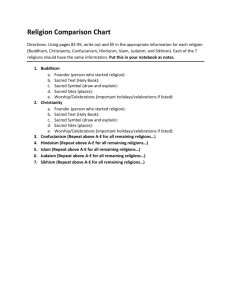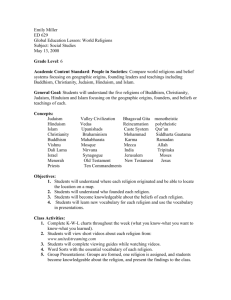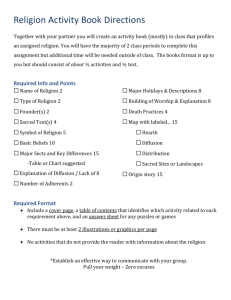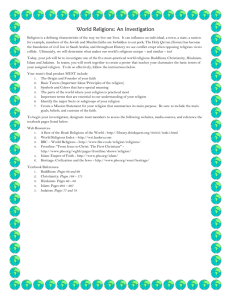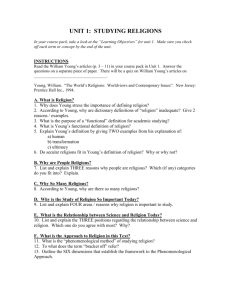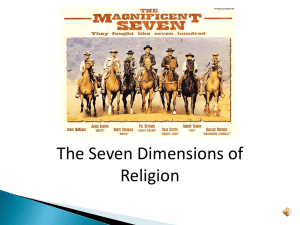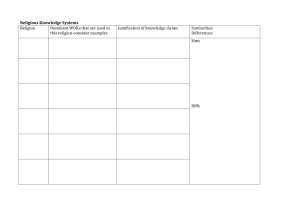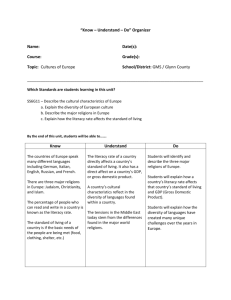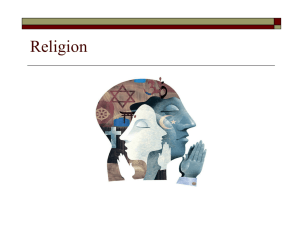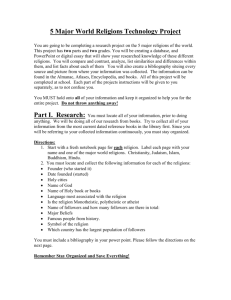Human Geography Learning Targets
advertisement
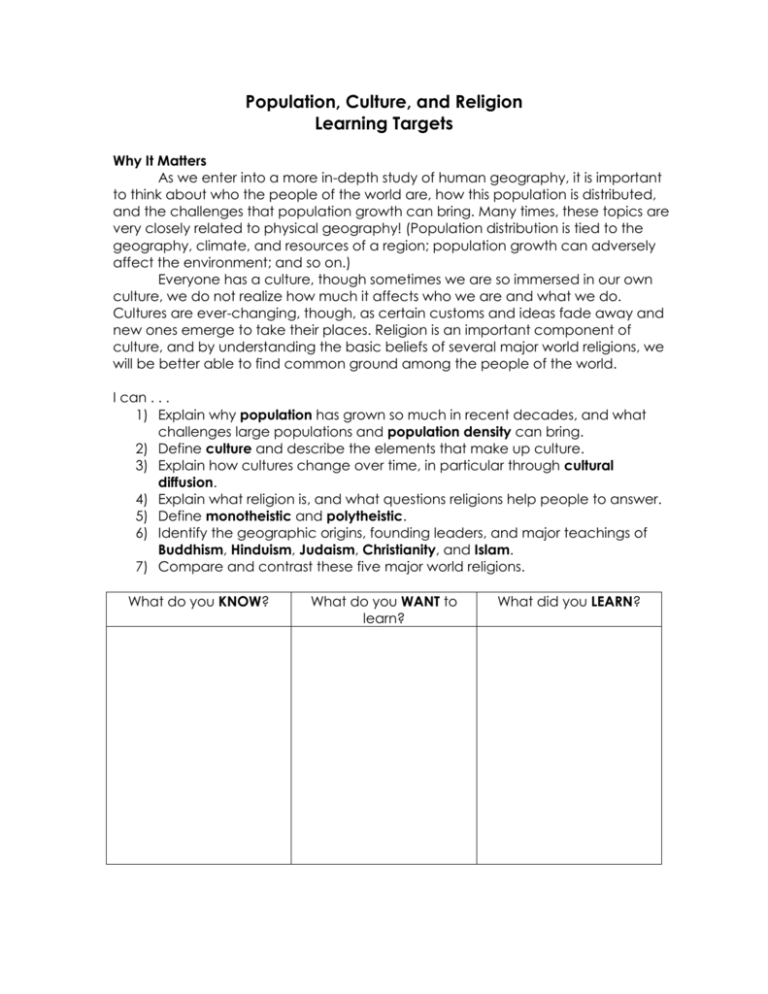
Population, Culture, and Religion Learning Targets Why It Matters As we enter into a more in-depth study of human geography, it is important to think about who the people of the world are, how this population is distributed, and the challenges that population growth can bring. Many times, these topics are very closely related to physical geography! (Population distribution is tied to the geography, climate, and resources of a region; population growth can adversely affect the environment; and so on.) Everyone has a culture, though sometimes we are so immersed in our own culture, we do not realize how much it affects who we are and what we do. Cultures are ever-changing, though, as certain customs and ideas fade away and new ones emerge to take their places. Religion is an important component of culture, and by understanding the basic beliefs of several major world religions, we will be better able to find common ground among the people of the world. I can . . . 1) Explain why population has grown so much in recent decades, and what challenges large populations and population density can bring. 2) Define culture and describe the elements that make up culture. 3) Explain how cultures change over time, in particular through cultural diffusion. 4) Explain what religion is, and what questions religions help people to answer. 5) Define monotheistic and polytheistic. 6) Identify the geographic origins, founding leaders, and major teachings of Buddhism, Hinduism, Judaism, Christianity, and Islam. 7) Compare and contrast these five major world religions. What do you KNOW? What do you WANT to learn? What did you LEARN? 7 Billion and Counting Directions: Use the article you received in class to complete each section of the notes below. Questions Notes Write three questions that somebody could answer by using ONLY your notes. What Ignited the Explosion? (Why has population grown so much?) 1. 1. Crowding the Earth (Can the Earth’s resources support more and more people?) 1. 2. 2. 2. Upsetting the Ecological Balance (How does overpopulation affect the environment?) 1. 2. 3. 3. Population Growth: American Style (Why is the “American lifestyle” a concern?) 1. 2. What Can Be Done? 1. 2. Summary Write a brief summary that tells the main ideas of the reading selection. Try to limit your summary to 3–4 sentences. Case Study: Population Density in Japan—Life in a Crowded Country Vocabulary: Population Density: ___________________________________________________________________________________ ____________________________________________________________________________________ Directions: Use the reading from class to complete the organizer below with two examples of how population density affects people’s day to day lives in Japan. Geographic Setting: How does Japan’s geography affect its population distribution (where people live)? _______________ _____________________________________________________________________________________________________________________ _____________________________________________________________________________________________________________________ How Population Density Affects Transportation How Population Density Affects Housing How Population Density Affects Land Use How Population Density Affects Health Vocabulary: Zero population growth: Case Study: China—The World’s Most Populous Country ____________________________________________________________________________________ ____________________________________________________________________________________ Directions: Use the reading from class to complete the organizer below with examples of how China is meeting the challenges of a large population. In the last column, share your thoughts about/response to China’s decisions. Geographic Setting: Which region of China has the largest population density? Why? ___________________________________ _____________________________________________________________________________________________________________________ _____________________________________________________________________________________________________________________ Challenge Rapid Population Growth Rising Energy Demands Increasing Jobs and Wealth Proposed Solution Benefits Costs Your Response Culture What Is Culture? Seven Elements of Culture Social Organization (families, friends, social classes) Customs and Traditions (rules of behavior) Economic Systems Culture: The way of life shared by a group of people Forms of Government Religion How do we learn our culture? _______________________________________ _______________________________________ Language Arts and Literature Ways Cultures Change: 1) New Technology ___________________ ____________________________________ ____________________________________ 2) Environmental Changes ____________ ____________________________________ ____________________________________ 3) Cultural Diffusion ___________________ ____________________________________ ____________________________________ Create a collage of words and pictures that represent your culture (at least 10 examples). Create a collage of words and pictures that show examples of cultural diffusion (at least 10 examples). Major World Religions: Judaism, Christianity, Islam, Hinduism, Buddhism What is religion? Why do all cultures have some form of religion? What questions does religion help humans to answer or try to understand? Two types of religions: Monotheistic Definition Examples Polytheistic Time Line of World Religions: When Did They Begin? 2000 B.C. 1500 B.C. 1000 B.C. 500 B.C. A.D. 1 500 1000 1500 A.D. 2000 _____________________________________________________________________________________________________________________________ _____________ Map Directions: Use the map provided in class (or your textbook, page 100) to shade in YOUR map to show the main regions where each of the world religions we will study are practiced today. Use five different colors, and do not forget to include a KEY at the bottom of the page. World Religions Chart - Complete the chart below for the world’s five major religions. Judaism (Jews) Christianity (Christians) Islam (Muslims) Monotheistic Monotheistic Monotheistic Where the religion was founded Founding Leader Middle East – Israel Middle East – Israel Middle East – Saudi Arabia Abraham Jesus Christ Muhammad Founding Beliefs Ten Commandments: These are a code for living a moral life. These 10 simple laws forbid stealing, murder, dishonesty, etc. Messiah: God will send a messiah/savior, but this person has not come yet. Role of Jesus: Christians believe that Jesus was the son of God and sacrificed himself to save humankind from punishment for their sins. They also believe that after his death, Jesus was resurrected and rose to Heaven. Christian Conduct: Christians believe they will go to Heaven after death if they have faith in Christ and treat others with love and respect. Five Pillars of Faith: 1. Allah is the one true God 2. Pray 5 times daily, facing the city of Mecca 3. Give charity to the poor 4. Fast during the month of Ramadan 5. Hajj—Make at least one pilgrimage (religious trip) to Mecca God or Gods % of world population that follows religion Sacred Text or Holy Book Sacred Symbol/ Special Object of Faith (write the name and sketch it) Sacred Site or City Special Day(s) World Religions Chart - Complete the chart below for the world’s five major religions. Buddhism (Buddhists) Hinduism (Hindus) No supreme being Polytheistic—Many gods and goddesses, though they are all forms of a single supreme being, Brahman Where the religion was founded Founding Leader India India Siddhartha Gautama (“the Buddha”) Unknown Founding Beliefs Four Noble Truths: These explain life’s meaning. These truths explain that pain and suffering are caused by human desires, like selfishness or the desire for wealth. By giving up these desires, a person can find peace and harmony. Eightfold Path: A set of 8 guidelines a person should follow in order to find peace (speak truthfully, respect all living things, meditate, etc.) Nirvana: By following the Eightfold Path, a person’s soul can break out of the cycle of reincarnations and achieve nirvana, a state of enlightenment and eternal peace. Reincarnation: Hindus believe that at death, a person’s soul is reborn as another living thing, creating a cycle of life, death, and rebirth. Eventually, a Hindu may “break out” of the cycle of rebirth and be reunited with Brahman. Karma: Karma refers to a person’s behavior in life, which Hindus believe will determine that person’s form in the next life. People who live a good life and earn good “karma” will be reborn in a higher caste (social class). God or Gods % of world population that follows religion Sacred Text or Holy Book Sacred Symbol/ Special Object of Faith (write the name and sketch it) Sacred Site or City Special Day(s)

